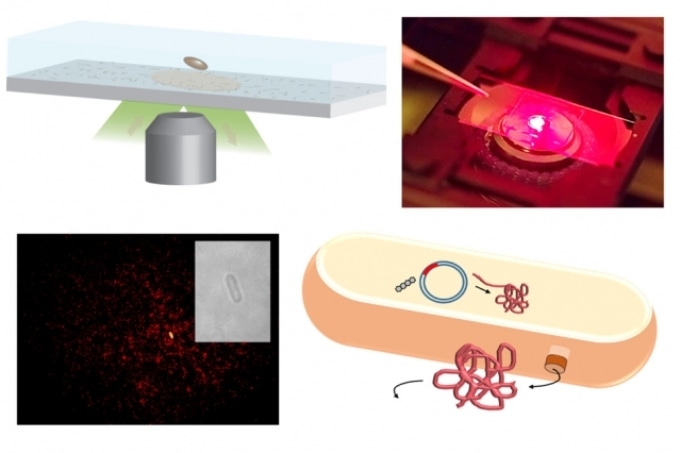Jan 24 2017
 MIT chemical engineers have developed arrays of carbon nanotube sensors that can detect single protein molecules as they are secreted from cells. (Courtesy of the researchers)
MIT chemical engineers have developed arrays of carbon nanotube sensors that can detect single protein molecules as they are secreted from cells. (Courtesy of the researchers)
For the first time, an MIT research team has developed sensors capable of detecting single protein molecules as they are secreted by a group of cells or even a single cell.
The researchers explain that these sensors are made up of chemically modified carbon nanotubes and could assist scientists with numerous applications that require detection of miniscule quantities of protein, such as monitoring cells’ manufacturing of constructive proteins, monitoring viral infection, or identifying food contamination.
We hope to use sensor arrays like this to look for the ‘needle in a haystack'. These arrays represent the most sensitive molecular sensing platforms that we have available to us technologically. You can functionalize them so you can see the stochastic fluctuations of single molecules binding to them.
Michael Strano, the Carbon P. Dubbs Professor of Chemical Engineering, MIT
Strano is the senior author of a Nature Nanotechnology paper published on January 23 explaining the new sensors. The paper’s lead author is Markita Landry, a former MIT postdoc who is currently an assistant professor at the University of California at Berkeley.
Other MIT authors are research scientist Hiroki Ando, former graduate student Allen Chen, postdocs Jicong Cao and Juyao Dong, and associate professor of electrical engineering and computer science Timothy Lu. Vishal Kottadiel of Harvard University and Linda Chio and Darwin Yang of the University of California at Berkeley are also authors.
No Detection Limit
Strano’s lab has previously built sensors that can identify several types of molecules, based on alterations of carbon nanotubes - hollow, nanometer-thick cylinders composed of carbon that naturally fluoresce when laser light is aimed at them. In order to convert the nanotubes into sensors, Strano’s lab coated them with DNA, proteins, or other molecules that can adhere to a specific target. When the target is adhered, the nanotubes’ fluorescence alters in a measurable manner.
Here, the researchers utilized strings of DNA known as aptamers to coat the carbon nanotubes. Earlier efforts to utilize DNA aptamers have been thwarted due to the complexity of getting the aptamer to adhere to the nanotube, while preserving the configuration it requires to adhere to its target.
Landry overcame this challenge by incorporating a “spacer” sequence between the section of the aptamer that adheres to the nanotube and the section that adheres to the target, allowing each section the freedom to execute its own function. The researchers effectively demonstrated sensors for a signaling a viral protein called HIV1 integrase and a protein called RAP1, and they trust the technique should work for several other proteins.
To track protein production of single cells, the team arranged an array of the sensors on a microscope slide. When a single bacterial, yeast or human cell, is placed on the array, the sensors could detect every time the cell secreted a molecule of the target protein.
Nanosensor arrays like this have no detection limit. They can see down to single molecules.
Michael Strano, the Carbon P. Dubbs Professor of Chemical Engineering, MIT
But, there is a tradeoff — the lesser the number of molecules, the longer it takes to sense them. As the molecule becomes more limited, detection can take an immeasurable quantity of time, Strano says.
“The new study by Strano and co-workers proposes an exciting new approach to detect proteins down to the single molecule level,” says Robert Hurt, a professor of engineering at Brown University who was not involved in the research. “The work pushes the forefront in single-protein detection and may allow researchers to see important, real-time molecular events at the single-cell level, such as protein release during cell division.”
Useful Tools
The sensor arrays could be practical for several different applications, the researchers say.
This platform will open a new path to detect trace amounts of proteins secreted by microorganisms. It will advance biological research [on] the generation of signal molecules, as well as the biopharmaceutical industry’s [efforts to monitor] microorganism health and product quality.
Juyao Dong, Postdoc, MIT
In the pharmaceutical sector, these sensors could be applied in analyzing cells engineered to help treat disease. A number of researchers are currently working on a technique where doctors would remove the cells of a patient, engineer them to secrete a therapeutic protein, and return them back into the patient.
“We think these nanosensor arrays are going to be useful tools for measuring these precious cells and making sure that they’re performing the way that you want them to,” Strano says.
He highlights that researchers could also apply the arrays to understand neurotransmitter function, viral infection, and a phenomenon known as quorum sensing, which permits bacteria to communicate with each other to harmonize their gene expression.